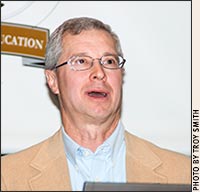Producing High-health Calves
Purdue veterinarian says treatment costs can be reduced with greater attention to nutrition and management early.
SAN DIEGO, Calif. (Jan. 27, 2016) — Mark Hilton would prefer that business was not quite so good. He would prefer that clients needed the services and products of his profession less frequently. He’s a veterinarian, but Hilton likes it when cattle producers don’t need to treat sick animals.

“Most cattlemen pay good money for disease, and it comes to their operations on four legs,” said Purdue University veterinarian Mark Hilton.
“I’m pro-nutrition and pro-management so you don’t have to use so much medicine,” Hilton told producers attending a Cattlemen’s College® session hosted during the 2016 Cattle Industry Convention in San Diego, Calif. The Purdue University veterinarian shared advice for raising healthy calves, reducing the incidence of disease and avoiding the associated costs.
The costs are great. As evidence Hilton explained how costs associated with treating feedlot cattle continue to climb. He cited data from 2014 showing that, on average, cattle feeders lost $119 on every animal that was treated for sickness one time. If an animal was treated twice, lost revenue increased to $365.
Hilton said cattle treatment costs incurred all along the production chain could be reduced with increased attention to nutrition and management, starting with the breeding female. Noting studies in fetal programming and epigenetics (environmentally influenced gene expression), Hilton reminded producers how nutrition during pregnancy has far-reaching effects, influencing fetus development, colostrum quality and quantity at calving, and the cow’s postcalving recovery and breed-back. He emphasized that pregnant cow nutrition impacts three generations — the cow, the calf she carries and her next calf.
Hilton advised producers to consult their veterinarian to develop and implement a vaccination plan for disease prevention. He said timing of vaccination and parasite control can be as important as product choice. Having a plan can save money.
According to Hilton, 99% of cow-calf producers have “open” herds, meaning they bring outside animals into the operation — as breeding bulls of females or as feeder cattle. It is cause for caution.
“Most cattlemen pay good money for disease, and it comes to their operations on four legs. The more cattle you buy, the more you open yourself up to introduction of disease,” stated Hilton, reminding producers to have a biosecurity plan, as well as targeted vaccination and parasite control programs.
Hilton emphasized the need to give calves a good start in life by optimizing the calving environment. He prefers calving outside, on clean ground, and at a time of year offering optimal conditions for calf survival.
“The goal is zero sickness in calves, or it should be, and that’s hard to achieve when you don’t calve in synch with nature,” said Hilton.
Recommending implementation of the Sandhills Calving System, Hilton explained the process of planning to use several pastures or lots for calving, so that every seven to 10 days, heavies can be moved away from cows that have already calved. The objective is to prevent new calf exposure to the environment contaminated by older calves. The resulting groups of pairs are not commingled again until the youngest calves are at least 4 weeks of age.
“It works,” Hilton said of the system. “Well-managed herds often reduce or eliminate scours.”
Hilton strongly recommended postweaning preconditioning of calves for at least 45 days prior to marketing. He advised producers to consider ways they take advantage of the time when calves can achieve the most efficient weight gains, by using the most economical means of putting pounds on cattle while ensuring better calf health through preconditioning.
Hilton advised calf sellers to “build a resume” based on how their cattle are managed. Calf buyers should know that weaned calves have more value. Weaning, in Hilton’s opinion, may be more important to future calf health than a vaccination program. Both make calves better yet.
“That,” said Hilton, “is the gold standard.”
Editor’s Note: The articles used within this site represent a mixture of copyrights.This article was written by or under contract of the Angus Journal, an Angus Media publication. If you would like to reprint or repost the article, you must first request permission by contacting the editor at 816-383-5270; 3201 Frederick Ave., Saint Joseph, MO 64506. The Angus Journal claims copyright to this website as presented. We welcome educational venues and cattlemen to link to this site as a service to their audience.

